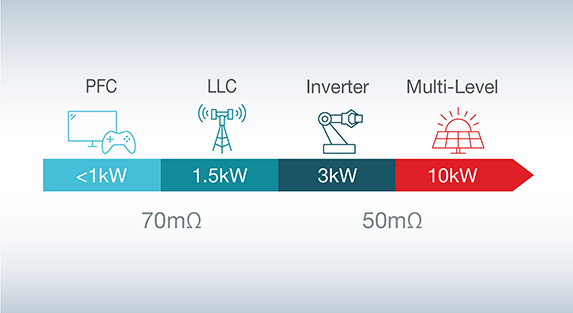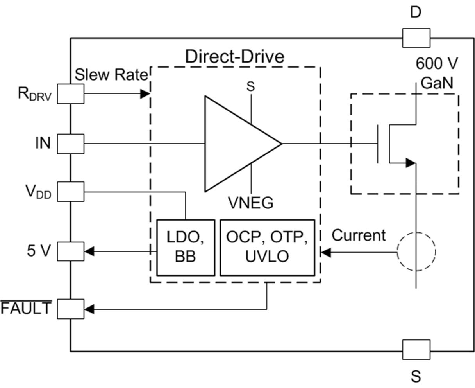SSZT565 december 2018 LMG3410R050 , LMG3410R070 , LMG3411R070 , LMG5200
Two years ago, TI announced its first 600-V gallium nitride (GaN) power device, which paved the way for engineers not only in power density and efficiency capability but also ease of design, with an integrated gate drive and robust device protection. Since then, we’ve worked to push the power levels as high (and as low) as possible with this cutting-edge technology.
GaN is pivotal at any power level where engineers are striving to increase switching speed, efficiency and reliability while decreasing size, weight and component count. Historically, you’ve had to trade off at least a few of these, but TI is enabling designs with all of these benefits, while saving system-level costs and board component count through sophisticated integration in one package. From cutting the size of your PC adapter in half to creating highly efficient and compact 10-kW conversions for grid-tied applications, TI offers a GaN solution for your design. The LMG3410 and LMG3411 families are rated at 600 V, and offer a variety of solutions from low-power adapters to over 2-kW designs.
Device Selection by On-state Resistance
Internal GaN field-effect transistors (FETs) are rated by RDS(on) – the drain-to-source, or on-state resistance – which plays a big role in the switching and conduction losses in power converters. These losses affect system-level efficiency and thermal and cooling methods. So in general, the lower the RDS(on) rating, the higher level of power achievable while still maintaining high efficiency. But there are some applications or topologies in which a higher RDS(on) may be more appropriate as shown in Figure 1.
 Figure 1 70- And 50-mΩ GaN Devices in Typical Power Topologies
Figure 1 70- And 50-mΩ GaN Devices in Typical Power TopologiesOvercurrent Protection
Integrated overcurrent protection not only eases layout and design for users, but high-speed detection is actually very necessary for device protection in case of a short circuit or other fault conditions. TI’s portfolio of GaN devices has <100-ns current response time to self-protect against unintended shoot-through events by safely shutting off the device and allowing it to reset. This protects both the device and the system from fault conditions read out from the fault pin as seen in Figure 2.
 Figure 2 Internal Device Structure for the LMG3410/LMG3411 Families, Including FET, Internal Gate Drive, Slew-rate Control and Protection Features
Figure 2 Internal Device Structure for the LMG3410/LMG3411 Families, Including FET, Internal Gate Drive, Slew-rate Control and Protection FeaturesTI’s default overcurrent protection method is classified as “current-latched” protection; meaning that, if any overcurrent fault is detected in the device, the FET will safely shut off and remain off until the fault resets. In our 70-mΩ devices, the fault is triggered at 36 A; for 50-mΩ devices, the fault trigger is extended to 61 A.
Depending on the application, some engineers may prefer to operate through reasonable transient conditions, for which we offer cycle-by-cycle overcurrent protection. With cycle-by-cycle protection, in the event of an overcurrent fault, the FET will safely shut off and the output fault signal will clear after the input pulse-width modulator goes low. The FET can turn back on during the next cycle and operate through transient conditions while still preventing the device from overheating.
Table 1 shows TI’s various GaN devices by their key specifications, structure and typical system power levels.
| Device | Voltage (V) | RDS(on) (mΩ) | FET configuration | Overcurrent protection method |
|---|---|---|---|---|
| LMG5200 | 80 | 15 | Half bridge | External |
| LMG3410R050 | 600 | 50 | Single channel | Latched |
| LMG3410R070 | 600 | 70 | Single channel | Latched |
| LMG3411R070 | 600 | 70 | Single channel | Cycle-by-cycle |
There is no doubt that GaN is at the leading edge of the semiconductor race for a superior power switch. With TI’s GaN devices now in mass production and targeting a wider range of solutions, we’re continuing to make it a more scalable and accessible technology for everyone in the power industry.
Additional Resources
- Read the blog posts:
- Download these application notes: